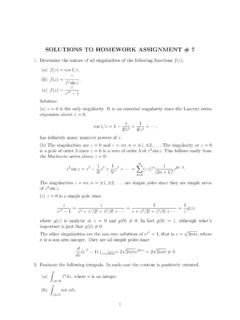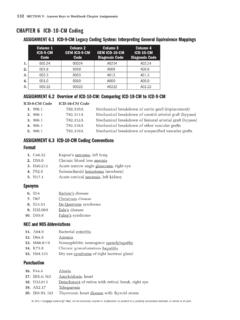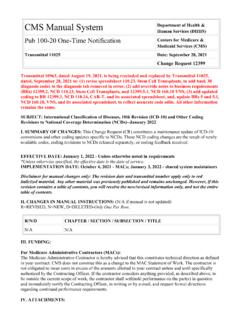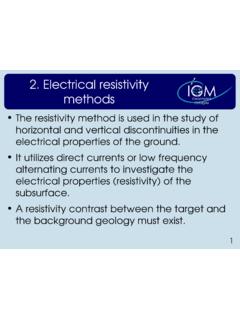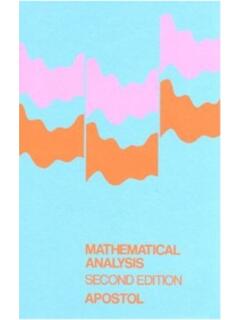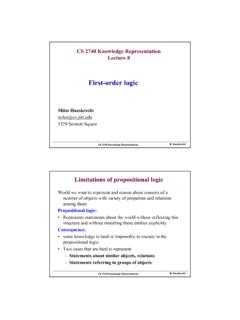Transcription of FUNDAMENTALS OF LINEAR ALGEBRA
1 FUNDAMENTALS OFLINEAR ALGEBRAJ ames B. 2005)2 Contents1 Introduction112 LINEAR Equations and LINEAR equations: the beginning of ALGEBRA .. Matrices .. Matrix Addition and Vectors .. Some Examples .. Matrix Product .. Reduced Row Echelon Form and Row Operations .. Solving LINEAR Systems via Gaussian Reduction .. Row Operations and Equivalent Systems .. The Homogeneous Case .. The Non-homogeneous Case .. Criteria for Consistency and Uniqueness .. Summary .. 363 More Matrix Matrix Multiplication .. The Transpose of a Matrix .. The Algebraic Laws .. Elementary Matrices and Row Operations .. Application to LINEAR Systems .. Matrix Inverses .. A Necessary and Sufficient Condition for Existence .. Methods for Finding Inverses .. Matrix Groups .. TheLPDUF actorization .. The Basic Ingredients:L, P, DandU.. The Main Result.
2 Further Uniqueness inLPDU.. Further Uniqueness inLPDU.. The symmetricLDUdecomposition .. Reduced Row Echelon Form .. Summary .. 734 Fields and Vector What is a Field? .. The Definition of a Field .. Arbitrary Sums and Products .. Examples .. An Algebraic Number Field .. The Integers Modulo a Primep.. A Field with Four Elements .. The Characteristic of a Field .. Connections With Number Theory .. The Field of Complex Numbers .. The Construction .. The Geometry ofC.. Vector Spaces .. The Notion of a Vector Space .. Examples .. Inner Product Spaces .. The Real Case .. Orthogonality .. Hermitian Inner Products .. Subspaces and Spanning Sets .. The Definition of a Subspace .. Summary .. 1175 Finite Dimensional Vector The Notion of Dimension .. LINEAR Independence .. The Definition of a Basis .. Bases and Dimension.
3 The Definition of Dimension .. Examples .. The Dimension Theorem .. An Application .. Examples .. Some Results on Matrices .. A Basis of the Column Space .. The Row Space ofAand the Ranks ofAandAT.. The Uniqueness of Row Echelon Form .. Intersections and Sums of Subspaces .. Intersections and Sums .. The Hausdorff Intersection Formula .. Direct Sums of Several Subspaces .. External Direct Sums .. Vector Space Quotients .. Equivalence Relations and Quotient Spaces .. Cosets .. Summary .. 1546 LINEAR Coding LINEAR Codes .. The Notion of a Code .. LINEAR Codes Defined by Generating Matrices .. The International Standard Book Number .. Error-Correcting Codes .. Hamming Distance .. The Key Result .. Codes With Large Minimal Distance .. Hadamard Codes .. A Maximization Problem .. Perfect LINEAR Codes .. A Geometric Problem.
4 How to Test for Perfection .. The Existence of Binary Hamming Codes .. Perfect Codes and Cosets .. The hat problem .. The Standard Decoding Table .. Summary .. 1827 LINEAR Definitions and Examples .. Mappings .. The Definition of a LINEAR Transformation .. Some Examples .. General Properties of LINEAR Transformations .. LINEAR Transformations onFnand Matrices .. Matrix LINEAR Transformations .. Composition and Multiplication .. An Example: Rotations ofR2.. Geometry of LINEAR Transformations onRn.. Transformations of the Plane .. Orthogonal Transformations .. The Matrix of a LINEAR Transformation .. The MatrixMBB (T) .. Coordinates With Respect to a Basis .. Changing Basis for the Matrix of a LINEAR Transfor-mation .. Further Results on LINEAR Transformations .. The Kernel and Image of a LINEAR Transformation .. Vector Space Isomorphisms.
5 Complex LINEAR Transformations .. Summary .. 2248 An Introduction to the Theory of The Definition of the Determinant .. The 1 1 and 2 2 Cases .. Some Combinatorial Preliminaries .. The Definition of the Determinant .. Permutations and Permutation Matrices .. The Determinant of a Permutation Matrix .. Determinants and Row Operations .. The Main Result .. Consequences .. Some Further Properties of the Determinant .. The Laplace Expansion .. The Case of Equal Rows .. Cramer s Rule .. The Inverse of a Matrix OverZ.. A Characterization of the Determinant .. The determinant of a LINEAR transformation .. Geometric Applications of the Determinant .. Cross and Vector Products .. Determinants and Volumes .. Lewis Carroll s identity .. A Concise Summary of Determinants .. Summary .. 2569 Dynamical Systems .. The Fibonacci Sequence .. The Eigenvalue Problem.
6 Fibonacci Revisted .. An Infinite Dimensional Example .. Eigentheory: the Basic Definitions .. Eigenpairs for LINEAR Transformations and Matrices . The Characteristic Polynomial .. Further Remarks on LINEAR Transformations .. Formulas for the Characteristic Polynomial .. Eigenvectors and Diagonalizability .. Semi-simple LINEAR Transformations and Diagonaliz-ability .. Eigenspaces .. When is a Matrix Diagonalizable? .. A Characterization .. Do Non-diagonalizable Matrices Exist? .. Tridiagonalization of Complex Matrices .. The Cayley-Hamilton Theorem .. The Exponential of a Matrix .. Powers of Matrices .. The Exponential .. Uncoupling systems .. Summary .. 29610 The Inner Product The Orthogonal Projection on a Subspace .. The Orthogonal Complement of a Subspace .. The Subspace Distance Problem .. The Projection on a Subspace .. Inconsistent Systems and the Pseudoinverse.
7 Applications of the Pseudoinverse .. Orthonormal Sets .. Some General Properties .. Orthonormal Bases .. Projections and Orthonormal Bases .. Gram-Schmidt and the QR-Factorization .. The Gram-Schmidt Method .. The QR-Decomposition .. Further Remarks on Inner Product Spaces .. The Space of LINEAR TransformationsL(Rn,Rn) .. The SpaceC[a,b] .. Hermitian Inner Products .. Isometries .. The Group of Rotations ofR3.. Rotations ofR3.. Rotation Groups of Solids .. Summary .. 33111 Unitary Diagonalization The Normal Matrix Theorem .. Normal Matrices and the Main Theorem .. Examples .. The Principal Axis Theorem .. Examples .. A Projection Formula for Symmetric Matrices .. Diagonalization of Self Adjoint Operators .. Self Adjoint Operators .. The Geometry of Self Adjointness .. Another Proof of the Principal Axis Theorem .. An Infinite Dimensional Self Adjoint Operator.
8 Summary .. 35512 Some Applications of Quadratic Forms .. The Definition .. Critical Point Theory .. Sylvester s Theorem .. Positive Definite Matrices .. A Test For Positivity .. Symmetric Matrices and Graph Theory .. The Adjacency Matrix and Regular Graphs .. Computing Eigenvalues .. The QR-Algorithm .. The QR-Convergence Theorem .. The Power Method .. Summary .. 375913 The Jordan Decomposition The Main Result .. Further Results on LINEAR Transformations .. The Cayley-Hamilton Theorem .. The Jordan Canonical Form .. A Connection With Number Theory .. Summary .. 39214 Basic Concepts .. Lines .. The Inner Product .. Planes .. Orthogonal Decomposition and Projection .. The Cauchy-Schwartz Inequality and Cosines .. Examples .. The Cross Product .. The Basic Definition .. Some further properties .. Examples and applications .. 40710 Chapter 1 IntroductionThis textbook is meant to be a mathematically complete and rigorous in-troduction to abstract LINEAR ALGEBRA for undergraduates, possibly even firstyear students, specializing in ALGEBRA is one of the most applicable areas of mathematics.
9 It isused by the pure mathematician and by the mathematically trained scien-tists of all disciplines. This book is directed more at the former audiencethan the latter, but it is hoped that the writing is sufficiently clear withenough detail so that the anyone reading the text can understand it. Whilethe book is written in an informal style and has many elementary examples,the propositions and theorems are generally carefully proved, and the inter-ested student will certainly be able to experience the theorem-proof style have throughout tried very hard to emphasize the fascinating andimportant interplay between ALGEBRA and geometry. The exercises are alsointended to emphasize this aspect. Some of them are very easy, some aremedium hard and a few are quite challenging . The hope is that the studentwill find them to be stimulating and a reason to think deeply about first two Chapters of the text cover standard beginning topics inlinear ALGEBRA : matrices, LINEAR systems, Gaussian elimination, inverses ofmatrices and the LDU decomposition.
10 In this material, we manage to definethe notion of a matrix group and give several examples, such as the generallinear group, the orthogonal group and the group ofn npermutationmatrices. In Chapter 3, we define the notion of a field and construct theprime fieldsFpas examples that will be used later on. We then introducethe notion of an abstract vector space over an arbitrary field and discuss1112some important speial cases, includingRnandCnas inner product fourth Chapter is devoted to proving the fundamental theorems onfinite dimensional vector spaces. We also treat the properties of also prove the Hausdorff Intersection Theorem and use it to treat directsums. We next construct the quotient of a vector space by a subspace. Directsums and quotients are used later when we begin to study eigentheory 5 is an introduction to LINEAR coding theory. The basic resultsabout error correcting codes are proven, and we treat perfect codes in somedetail.


